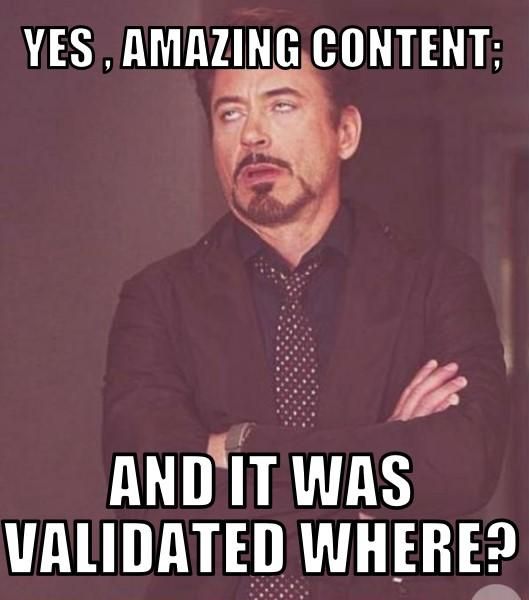Content strategy is great when you’re in the driver’s seat and all stakeholders are on the same page. You have in front of you exactly what you need to understand every element of the client’s problem and carry out the phases required to make the project a success.
Unfortunately, I’ve seldom seen this become reality. Especially in large companies where employees are being ‘politely’ told by their managers to listen to and help the nice user experience people.
Instead, what I have seen time and again is a UX project almost brought to its knees due to unforeseen elements; or stakeholder disharmony that is staring you in the face, right from the start. Both of these unwanted circumstances usually raise their ugly heads through content and its (sometimes reluctant) owners.
5 caveats of content:
#1 – Lack of content
The project is a startup or brand-new element to an existing system. Being given the ‘green light’ by the big cheeses, the shiny solution that needs validating is in someone’s head or on the back of a Costa’s receipt. How it’s going to be expressed to the customer ‘isn’t quite there yet…’
#2 – Too much content
The new project is a lot more complex than first anticipated or the existing system has become a lumbering behemoth full of content skin tags hidden under the folds of its time-worn hide.
#3 – Duplicated content thanks to multiple owners
The existing system is presumed to be in tip-top condition with owners keeping a close eye on each other’s work and communicating any new ownership when people leave the department or the company.
I haven’t seen this ‘dream world’ scenario. This is where the ‘silos’ of a company emerge from the woodwork. Either through internal politics or plain old bad communication, content is now duplicated or triplicated and all sitting on the same server, saying the same thing, but in very different ways!
#4 – Inconsistent terminology and overuse of buzzwords and acronyms
A business’s marketing strategy needs to display consistency, therefore, becoming omnichannel. All content strategy within a company could learn a lot from this. Employees’ understanding of processes would be uniform and unambiguous, making them confident ambassadors. Customers would easily understand why they are investing in that company’s product or service. Recommendation will soon follow!
Unfortunately, thanks to points covered in #2 and #3 above, a haphazard use of what content owners ‘think’ is terminology and a trend towards acronym overuse alongside this week’s buzzword, presents nothing more than a mess.
#5 – Out-of-date content
Out-of-date-content needn’t mean information that hasn’t been touched for decades – although this is usually the case when it appears in a project. One particular project I was involved in had got to the MVP (Minimum Viable Product) stage of a rather complex customer portal, only to be told by the legal team that as of the following week, all terms and conditions, policies, etc. would be required to be reworded. Even for testing purposes!
Had the legal team got the new content to hand and was it ready for circulation? Of course not! So, in hindsight, by including a legal team stakeholder and holding off on the project start by maybe a week or two, everything could have remained tickety-boo.
This is definitely not an exhaustive list and you may have already thought of more content caveats while reading these.
All of the above caveats can be unearthed at some point in a project’s proceedings. User testing, in particular, will find the rotten content apple at the bottom of the barrel. When the outcomes are presented to the stakeholders this can bring the whole project to a grinding halt depending on the severity and how it affected the users tested.
Maybe you will be lucky time and again. There’ll be no stakeholder friction towards your team and its ‘dark arts.’
But just in case, and to stop Holst’s Mars: the bringer of war being the soundtrack to stakeholder meetings further down the project’s road map, …
… here’s:
3 steps to make content strategy part of your discovery phase
Step #1 The brief – is it wearing its heart on its sleeve?
Before you’ve met any of the stakeholders, your team will (in most cases) be given a brief. This will describe what the main stakeholders are seeing as the problem that they want a solution to. Of course, UX can turn this on its head. But that’s another box of fun and games to be opened later in the project.
Look for clues within the brief about content management.
Has the project taken place before but was shelved? How recent was this? Who owns any quantitative/qualitative data that was garnered from it? This innocuous little insight within the brief can offer an overview of the state of existing content. Or even the lack of it. It also highlights the direction stakeholder interviews can go in and which silos need to be involved.
If you’ve had an introductory meeting with a stakeholder: does the brief showcase the same terminology and understanding of the problem? If another stakeholder has written the brief, then this could be the first signs of ‘stakeholder disharmony.’
Step #2 The stakeholder interview – get the silos out of the woodwork
Getting chief stakeholders to bring forward content owners at the stakeholder interview stage can hopefully prevent the make-or-break situations that I’ve touched on. In the interview, elaborate on any questions that have arisen from the brief (see Step #1). Also, don’t be afraid to ask about any other names that have crept in from other documentation. Or about extra individuals suddenly appearing in the CC field in email conversations that haven’t been formally introduced.
These could be the names behind the legal team and speaking early on to them could prevent any surprise content blockers. Always seek permission from chief stakeholders to directly speak to new names on the project. The sensitivity of the content may need the introduction of NDAs (Non-Disclosure Agreements). Or maybe a ‘no-go area’ and another blocker!
Step #3 – Create communication funnels
So, the silos have come out of the woodwork. The content owners you’ve spoken to have solemnly sworn that:
- all existing content is up to date.
- there is no new legally-binding content around the corner that’s about to jump out from the bushes.
- there is no HiPPO (Highest Paid Person’s Opinion) about to gate crash the party and undermine everyone’s hard work with the greatest content ever (according to said HiPPO)!
- the terminology used is the same throughout the company and will be understood by users.
- the content is consistent and is a shining example of the business’s tone of voice.
Even if only one of these points has been fulfilled, you are at least moving in the right direction. You are getting the business to think as one – you’re making their working lives and your own easier at the earliest stage of the project.
The beginnings of a beautiful content strategy
But now, the sound of many voices needs to be whittled down to just one or two chief stakeholders. Preferably, the people who came to you in the first place to kick start the project. Even if they are not totally on board with UX and how you work, you need them to know how important they are going to be for you to get the job done.
These communication funnels will need to be moderators of all that comes in (at the very least content-wise) from the other stakeholders connected to the project via the business. Hopefully, their task will be easy and within days of the stakeholder interviews, your UX team will have the beginnings of a beautiful content strategy delivered and laid out before you. Now you can get on with making the UX magic happen.

You are not here to chase content nor listen to endless arguments over process, terminology, and business-wide acronyms. The project should be harmonious, almost bordering on fun, as stakeholders realize the joy of making a customer happy via a united team.
It shouldn’t have them running back to the safety of their silos while the HiPPO shoehorns their content into their project to the sound of Mars: the bringer of war!
Keep your chief stakeholders in the loop
This is where your chief stakeholder ‘moderators’ need to be keeping an eye on the communication funnel. This doesn’t mean that you need to cut off all communication with the other stakeholders. Any updates on content or other aspects of the project are more than welcome. But your chief stakeholders need to be kept in the loop.
Whether it’s an email thread, an unexpected Skype call, or new Trello activity – the chief stakeholders need to be included or updated as soon as possible. If your team is being pressured in any way over what content should be published for the project, you can politely tell the stakeholder to arrange a meeting that will also include the chief stakeholders.
Make your proposal water-tight and don’t be afraid to wave it under clients’ noses.
If things continue to go awry content-wise after following my discovery phase steps, then you need to remind the stakeholders (and it can be all of them at once) about the proposal that your team handed out in reply to the client’s brief. Hopefully, somewhere in that proposal is a ‘dependencies section’ and amongst those paragraphs or listed points, you will find:
- Stakeholders will be available for workshops, interviews, testing, and observations. (In other words: all of you should know what’s going on – if you can’t be there, you send someone to represent you.)
- Business sponsors are committed to a user-centered design approach and will accept challenges to current practice based on evidenced research. (In other words: Shut up and listen to your customers for once.)
And here’s the biggy:
- The user experience team will not be responsible for copywriting. Mandatory content will be supplied at the earliest possible time by the client.
And then throw in a dash of assumption with:
- The content and resources supplied by the client will be in a suitable form to be included in the project.
Remember: every project is as individual as the stakeholders you’ll meet.
Just look for the early warning signs of internal politics and lumbering content behemoths. Especially if the client is a well-established and large company. Most clients will be stuck in their ways in some shape or form; but you want the content to flow easily because you want the customer journey to do the same – then everyone wins!
I hope your future stakeholder meeting soundtracks sound something like this:

